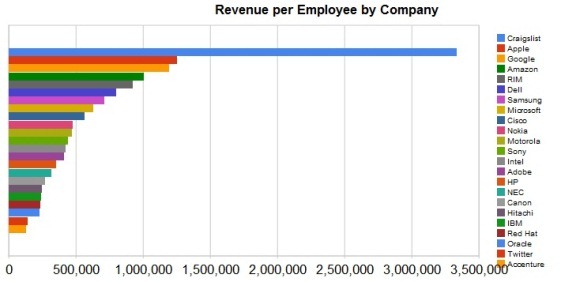 A friend of mine who heads business intelligence at a public web company taught me a little hack that does seem to work pretty well to figure out the revenues of any pre-public SaaS/web services company. Here is the formula:
A friend of mine who heads business intelligence at a public web company taught me a little hack that does seem to work pretty well to figure out the revenues of any pre-public SaaS/web services company. Here is the formula:
- Take the # of employees the SaaS company has, as reported on LinkedIn’s Company profile for that company.
and
- Multiply by $150,000 if well-funded. $200,000 if modestly funded.
And that’s the company’s revenues. All done.
If the company is very heavily funded (>$40m+ plus, growing quickly), it may be as low as $100,000 in revenue per employee. If it’s self-funded, and/or is primarily freemium, the number may be as high as $300,000. (Higher than that is rare in SaaS, if less so in successful consumer internet).
But on average $150k revenue if well funded, else $200k / employee seems to work pretty well as soon as you are past a few million in ARR. And LinkedIn is pretty accurate in telling you employee headcount, since basically everyone fills out their LinkedIn profile.
Let’s do a few checks, and compare to the actual company revenues we have for 2011 on a GAAP basis from our friends at Inc:
- Marketo. 368 employees. x $200k = $74m ARR. Could be. Lots of capital. x $150k = $55m ARR. More likely.
- Hubspot. 468 employees x $150k = $70m ARR. Probably too high since they did $29m in GAAP in 2011. But lots of capital. Update: actual number is $60m in ARR. Super high growth rate pushes it down a bit below $150k.
- YouSendit. YSI is primarily freemium but well funded. So 235 employees x say $250k = $58m ARR. Exactly what they recently reported on TechCrunch (YouSendIt Acquires Found To Enable Integrated File Search Across Apps, Devices, Cloud Storage Platforms And More | TechCrunch) — and makes sense if they did $38m in GAAP the past year.
Anyhow I know this is no secret. And it just gives you a range, but if you move the revenue number back and forth based on funding, stage, and business model … it gets you pretty close.
It’s especially useful for companies you have an interest in, but simply no idea how big they are.
{A nice summary for more mature tech companies at scale is here:
and a broader one here with a great Google Doc spreadsheet:



